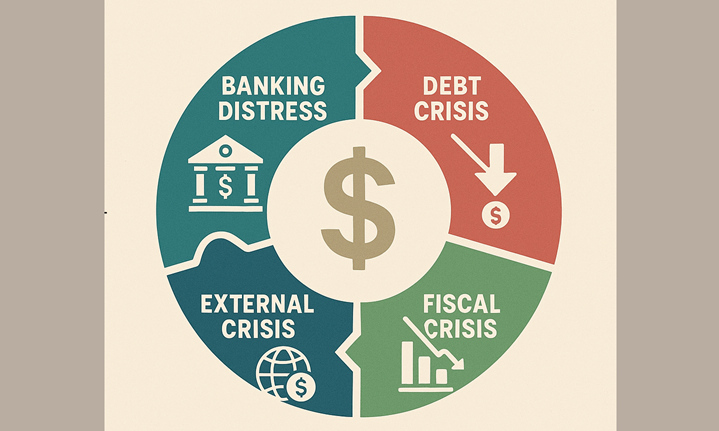
Cycles of Crisis: An Analysis of Bangladesh's Financial Sector
Published on: June 25, 2025
Cycles of Crisis
An infographic dissecting the systemic financial vulnerabilities behind Bangladesh's paradoxical story of high economic growth and pervasive institutional decay.
A Tale of Two Crashes
Bangladesh's capital market history is defined by two major collapses, 14 years apart, revealing a consistent pattern of manipulation, regulatory failure, and impunity.
1996: The First Shock
A speculative bubble fueled by political optimism and primitive market infrastructure.
- 📈Index peaked at 3,648 points
- 👥25,000 retail investors affected
- 🔧Fraud Tactic: Fake paper share certificates
- ⚖️Outcome: Investigation ignored, no perpetrators jailed
2010-11: Recurring Nightmare
Despite a modernized digital system, a more sophisticated scam unfolded with the same root causes.
- 📉Index fell 1,800 points in weeks
- 👥3.25 Million retail investors affected
- 💻Fraud Tactic: Misuse of omnibus accounts & asset overvaluation
- ⚖️Outcome: Probe report shelved, ~60 masterminds never prosecuted
The Great Bank Heists
Beyond market crashes, a more deliberate plunder has crippled the banking and Non-Bank Financial Institution (NBFI) sectors through orchestrated loan scams.
Total Estimated Embezzlement via Major Scams (2008-2023)
Tk 92,261 Crore
(Source: Centre for Policy Dialogue)
Scale of Major Scandals (in Billion Taka)
This chart compares the staggering financial losses from four of the most infamous institutional heists.
Anatomy of a Heist
Large-scale loan scams follow a predictable pattern, beginning with political influence and ending in capital flight. This flowchart illustrates the typical five-step process.
Political Patronage
Politically connected individuals are appointed to the board.
Control Capture
The new board bypasses internal controls and credit committees.
Fraudulent Lending
Massive loans are approved to fictitious shell companies.
Siphoning Funds
Loan money is rapidly moved through complex transactions.
Capital Flight
The embezzled funds are laundered out of the country.
The Public Betrayed
A new frontier of fraud targets the general public directly, exploiting low financial literacy and regulatory gaps in MLM and E-commerce.
The Economic & Social Fallout
The relentless cycle of scandals inflicts deep and lasting damage on the nation's economy and social fabric.
Crippling Non-Performing Loans (NPLs)
The direct result of loan scams is a mountain of bad debt that paralyses the banking sector. The official NPL rate is widely believed to be a fraction of the real figure.
Erosion of Trust & Inequality
The scandals have shattered public faith in financial and state institutions. This systemic plunder represents a massive illicit transfer of wealth from ordinary citizens to a small, powerful elite, widening the gap between the rich and poor.
A Blueprint for Reform
Experts from the World Bank, IMF, and CPD agree on a core set of structural reforms needed to break the cycle of crisis. The challenge is not the lack of solutions, but the lack of political will.
Institutional Autonomy
Free regulators like Bangladesh Bank from political capture. Reform appointment processes and grant the central bank full resolution powers.
Legal & Judicial Overhaul
Enact a modern bankruptcy law for swift loan recovery. Establish specialized commercial courts to expedite financial crime cases.
Governance Reform
Restructure bank boards with qualified professionals, limit family control, and empower genuinely independent directors.
Accountability & Enforcement
Depoliticize and empower the Anti-Corruption Commission. Prosecute high-profile perpetrators to end the culture of impunity.

Written by
Sajid Hasan
Sajid is a writer and analyst focusing on market dynamics and strategic business movements in South Asia.


